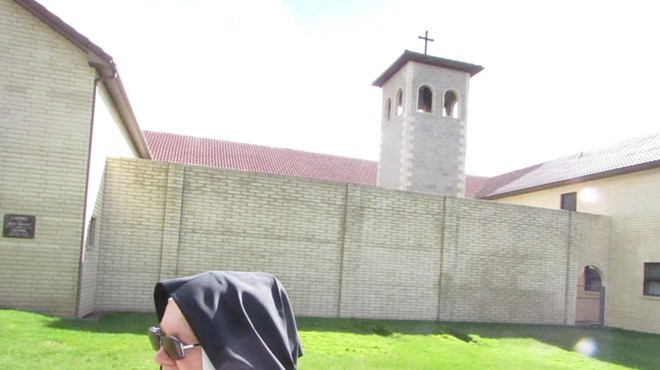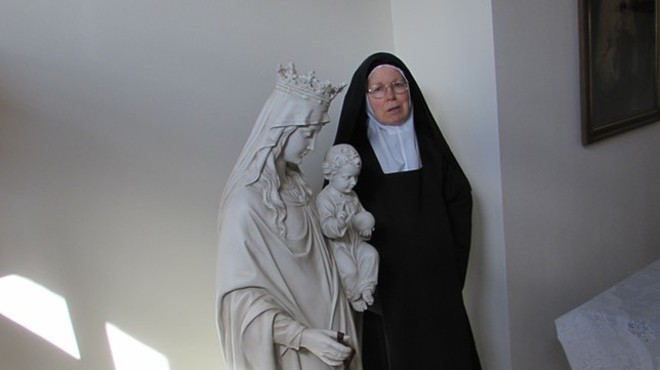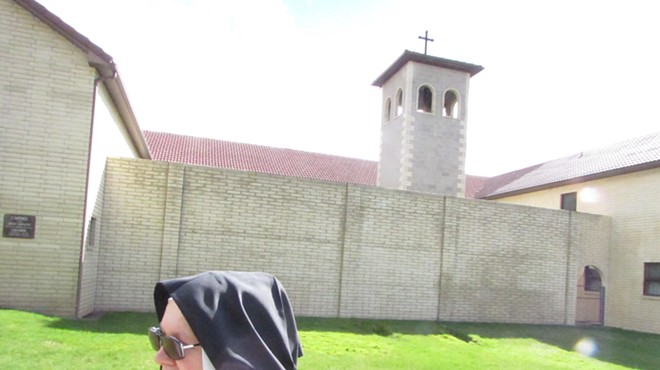The letter, dated March 4, 2015, was written on an electronic typewriter, and hand-delivered by a priest to a Spokane Valley Comprehensive Plan meeting.
"We are a community of contemplative, cloistered nuns," the letter reads. "Our monastic Rule prescribes that we live in desert places in order to be able to work and pray in silence because 'Silence is the way to foster holiness'... it is an essential part of holy life."
A 10-foot-high wooden fence surrounds the 18 acres at Spokane Valley's Carmel of the Holy Trinity monastery. Nobody can see in, nobody can see out. That, of course, didn't stop golf balls — and the occasional golf club — from the nearby Painted Hills Golf Course from soaring over the monastery's walls.
Today, the course has been shuttered. The fairways and greens are overgrown with weeds. In 2013, developer Dave Black plucked the property from a bankruptcy auction, and now has early plans for a Kendall Yards-style development in the nearly 100-acre space, complete with a park, trails, cottages, gated communities and an apartment complex.
That last piece, in particular, is what has a group of cloistered nuns sending letters regarding municipal zoning: They worry about the loss of privacy and quiet with "a huge complex plunging the view of its inhabitants over our cloister wall! There would be no more privacy, and one can easily imagine the noise of blaring stereos, etc."
The Painted Hills proposal has drawn the typical neighborhood concerns over the impact of the development on traffic, property values, flooding and the local ecology. But the Carmel of the Holy Trinity represents a far more unusual case: A development decision with theological import.
Hidden from sight
It's Saturday morning on the 500th anniversary of the birth of St. Teresa of Ávila. The air is sweet with incense in a small chapel at the Carmel of the Holy Trinity, as around two dozen parishioners line up, one by one, and kiss a relic said to be a remnant of the saint's body.
The local Catholic diocese, however, doesn't recognize this group, calling it "schismatic." After all, the Carmel of the Holy Trinity doesn't abide by the changes of the early-1960s Second Vatican Council. Mass is still in Latin, and female parishioners still have their heads covered.
The men in white robes up front sing their Latin Gregorian chants. Female voices sing responses through the wall. Even during Mass, the nuns here remain cloistered, hidden behind a wall without a view of the congregation.
So when I speak with the prioress, I don't get to see her face, and she doesn't get to see mine. The faces of strangers are considered distractions. Instead, I hear Mother Marie of Jesus Hostia's South African-accented voice from a black screen behind a barred grate. She only leaves these walls for medical reasons.
"It's such a relief to get back in when we have to get out, I assure you," Marie says, noting the immodesty and emptiness of the outside world. "You can see they're running after so much rubbish."
Yes, isolation and adhering to the rules of a strict regimen is a sacrifice, she says. But she believes that by dedicating her life to constant, isolated prayer, petitioning God for mercy, the whole world benefits.
When the nuns moved into this monastery in 1990, the area was still farmland and forest. Within five years, housing developments already had begun to spring up. By now, there's a subdivision directly to the north, and the nuns are resigned to that. Mostly the neighbors are respectful, the nuns say, though they remember one time that a man yelled obscenities at them after spotting them from his second-story window.
They worry that an apartment complex rising above the monastery walls could make being gawked at or jeered at more common. "We are not in a zoo," Marie says. "It's a private thing, a private life."
NAI Black development manager Bryan Walker says he hasn't talked to anyone with the monastery yet, though he's tried.
"I really went over to them to ask them if they wanted to relocate and [sell] their property," Walker says. But he says there was no answer at the door.
He argues that the planned residential development, with its sidewalks, retailers and park space, includes input from three neighborhood meetings and is far superior to the generic rows of suburban houses that existing zoning allows.
Walker suggests that the apartment complex could be angled to avoid directly looking down on the monastery grounds. "I think there are ways of designing that so they have the same amount of privacy, if not more," Walker says.
But Marie says NAI Black would have to go further: In Europe, some buildings don't have windows at all on the side overlooking monastery grounds. If not, there are alternative remedies.
"We can put up quite high screens if we have to," Marie says. But that has a downside as well, blocking the gorgeous views of the mountains for both the nuns and their neighbors.
Hidden from sound
Blocking views is one thing. Blocking sound is another. The Carmelites draw a lesson from the prophet Elijah, who is said to have heard the "still, small voice" of God, not amid the bombast of fires, earthquakes or mountain-splitting winds, but in silence and solitude. Silence, here, is a strictly followed virtue.
With a few brief exceptions each day, the sisters only speak when absolutely necessary, often using a custom sign language to communicate. During the "Grand Silence" in the evenings, the nuns even move slowly, to reduce sound. "It's in silence that you can have the peace of mind and force of concentration to be able to concentrate on God," Marie says.
The fear is that the noise from surrounding cottages, houses and apartments will intrude into the atmosphere of silent meditation. Some old European monasteries, Marie says, had stone walls 30 feet high that helped keep out the sound.
"We are not allowed to do that here," she says. Other than stopping the development entirely, she doesn't see a clear solution.
Spokane Valley City Councilman Ed Pace says he's met with constituents concerned about the development, but since all that NAI Black needs is a "planned residential development" overlay — not a zoning change — it's out of the council's hands. Eventually, it will be up to the Spokane County hearing examiner to make the decision.
"If the monastery is there... that's part of the character of the existing neighborhood," Pace says. That's a factor the hearing examiner is required to consider.
The nuns, of course, won't be able to attend the hearing themselves. But from behind their fences and grates and monastery walls, they'll be rooting for an outcome.
"We hope that the whole thing fails," Marie says. ♦

























